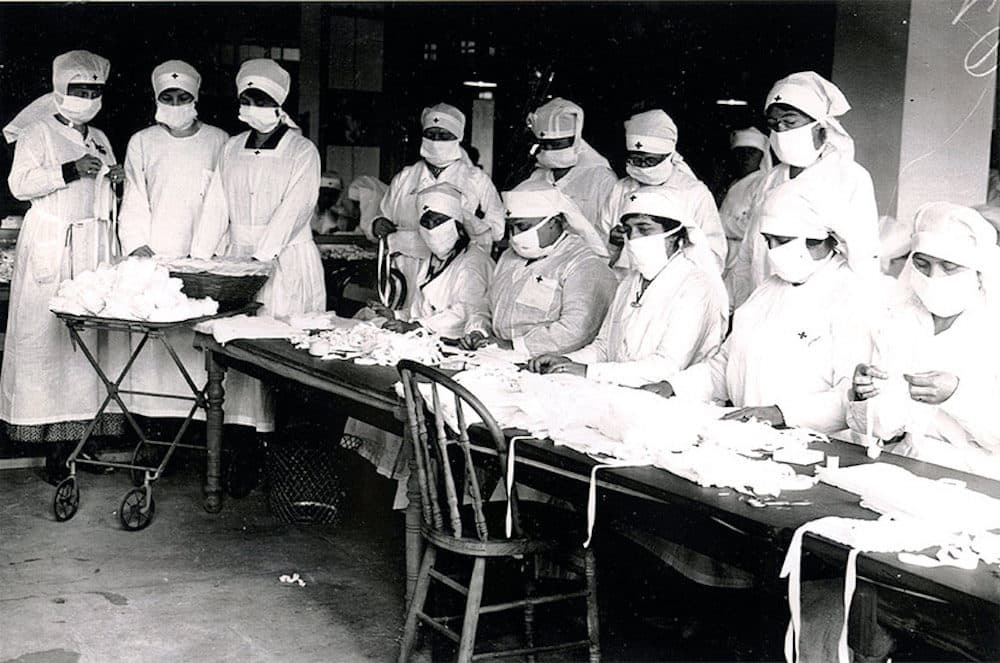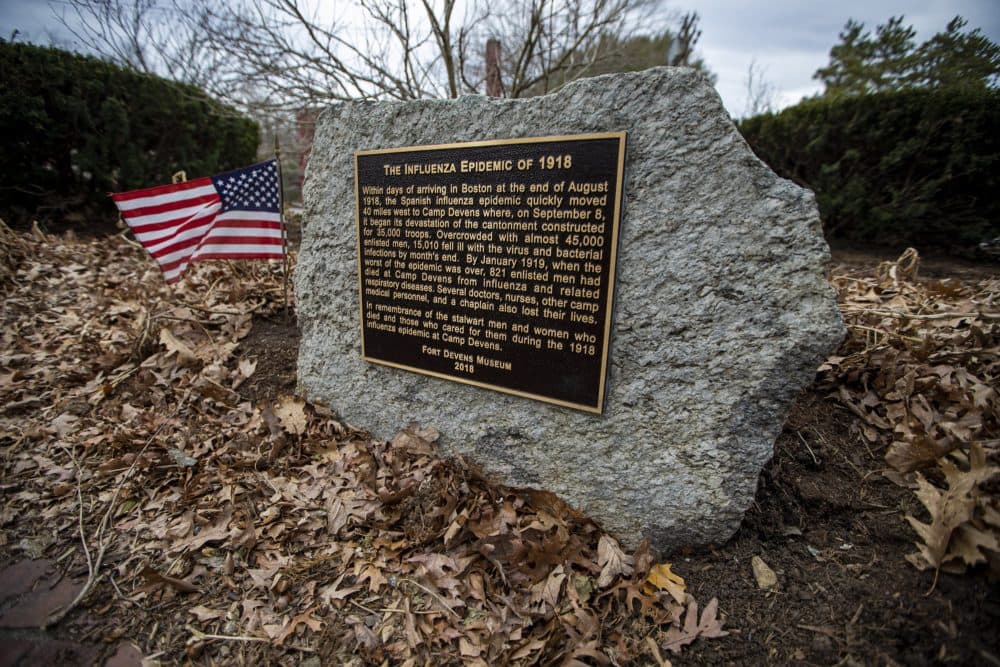Advertisement
How Boston Reacted To The 1918 Flu Pandemic

It was late September in 1918 when a doctor at what was then Camp Devens in Ayer summed up the new disease that was killing thousands.
"Two hours after admission they have the mahogany spots over the cheek bones, and a few hours later you can begin to see the cyanosis extending from their ears and spreading all over the face," the doctor said. "It is only a matter of a few hours then until death comes, and it is simply a struggle for air until they suffocate. It is horrible."
Devens was not the first place to see an influenza outbreak that year, but it was one of the hardest hit. It's estimated about a third of people at the camp came down with the flu — a little more than 15,000. Of those, more than 800 died.
"That happening really overwhelmed the hospital here," said Kara Fossey, the executive director of the Fort Devens Museum. "They pulled in some nurses in from other places. There were some nurses and doctors that died here as well. They had to use barracks for makeshift morgues to even deal with all the people."

What was happening in Devens — where the Army surgeon general observed bodies "stacked about the morgue like cordwood" — was a snapshot of what was happening at the same time in Boston.
There, the virus appears to have started among sailors at Commonwealth Pier in late August. And it spread quickly. On September 6, 1918, the Boston Daily Globe reported that there were 300 cases of the flu at Commonwealth Pier.
Four days later, the number had risen to 1,100, prompting this warning: "Boston health authorities who are combating the grippe ask the cooperation of girls who have sailor friends, requesting them to refrain from kissing."
On September 23, the Globe noted that all hospitals were "taxed to their limits." Two days later, Boston Public Schools were shut down and the emergency health committee banned all public gatherings.
In the days that followed, the city health commissioner ordered all places of amusement closed, the sheriff quarantined the Charles Street Jail and the governor made a desperate call for more health care workers.
Advertisement
"I most strongly urge that the public authorities release nurses engaged in work not at this time pressing and that householders dispense with all non-emergency service so that additional nurses may be available for the more serious cases of influenza," read a proclamation by the governor at the time, signed by the lieutenant governor and future president, Calvin Coolidge.
"It is earnestly requested that everyone who has had medical or nursing experience or who can assist in any way communicate with the Commissioner of Health at the State House," the proclamation continued.

The worst of the epidemic lasted for about four weeks. In that time, there were multiple days with more than 150 dead from flu or pneumonia. It wasn't until the number of deaths in Boston dipped below 100 for the second time in three days that the mayor allows bars and theaters to reopen.
The current coronavirus outbreak has not created the same sorts of conditions the 1918 flu pandemic did in Boston.
But Alex Navarro, the assistant director of the University of Michigan's Center for the History of Medicine said there is good reason to look back at 1918.
"It was a global pandemic," Navarro said. "It was one of incredibly high death toll, and caseload, and one also in the quote-unquote, modern era."
Navarro, whose research looked at the flu outbreak in dozens of American cities, including Boston, said the most effective tools governments were able to use were those that isolated the sick and prevented infection — like Boston's ban on public gatherings.
"Timing is really key," he said. "Our study found that association between cities that acted early, that kept many different non pharmaceutical intervention and social distancing measures in place, and that kept them in place for longer fared better."
In other words, telling people to stay home or avoid people who are sick works.
But, he acknowledged, that's not always possible — especially for public leaders who face a skeptical public that might want restrictions to end. Indeed, Navarro said that was the case in some cities that saw a second wave of influenza after lifting bans too early.
"So as a historian, I can tell you that the data suggests that they work, but as a public health official having to make these decisions, they're in a really difficult spot," he said.
It's estimated the 1918 flu killed about 2.5% of those infected. We still don't know how deadly the new coronavirus really is. Germany has reported just two deaths out of more than a thousand cases. South Korea's case fatality rate is about 0.7%.
But in Italy, the death rate has been closer to 6%.
"We don't want to be alarmist and we don't want to say the sky is falling,” said Navarro. “But if you look at the data we have so far, we have a disease that has about the same transmissibility rate as influenza and has a case fatality ratio that is probably on par with what the 1918 epidemic was."
This segment aired on March 11, 2020.
